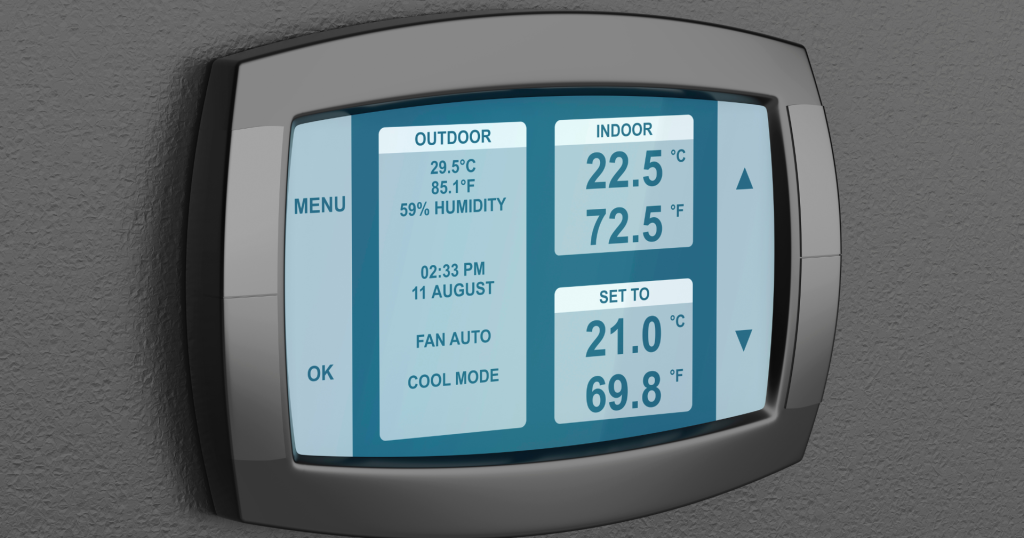Say goodbye to manual temperature adjustments and hello to effortless smart thermostats and control! Discover the power of home automation today.
As we continue to rely on technology to make our lives easier and more convenient, home automation has become increasingly popular. Home automation refers to the use of technology to control and automate household appliances and systems, such as lighting, security, and temperature.
One of the most important components of home automation is smart thermostats and control. These devices have revolutionized the way we control the temperature in our homes, providing greater comfort, convenience, and energy efficiency.
Introduction to Smart Thermostats and Control
A smart thermostat is a device that can automatically adjust the temperature in your home based on various factors, such as the time of day, the weather, and your personal preferences. These thermostats can be controlled remotely using a smartphone app, and some can even learn your habits and adjust the temperature accordingly. Smart controls, on the other hand, allow you to control your heating and cooling system using your voice or a smartphone app, even if you don’t have a smart thermostat.
How Smart Thermostats Work
Definition of Smart Thermostats
Smart thermostats are designed to be more intelligent and adaptive than traditional thermostats. They use sensors and algorithms to learn your habits and preferences, and they can adjust the temperature accordingly to save energy and provide greater comfort. Some smart thermostats can also be controlled remotely using a smartphone app or voice commands.
Types of Smart Thermostats
There are three main types of smart thermostats: learning thermostats, programmable thermostats, and remote-controlled thermostats.
Learning Thermostats
Learning thermostats are the most advanced type of smart thermostat. They use machine learning algorithms to learn your habits and preferences over time, and they can adjust the temperature automatically based on this information. Some learning thermostats can also detect when you’re not at home and adjust the temperature accordingly to save energy.
Programmable Thermostats
Programmable thermostats allow you to set a schedule for your heating and cooling system. You can program them to turn on and off at specific times of day, depending on your schedule and preferences. While they don’t have the learning capabilities of a learning thermostat, they can still help you save energy and money by only heating or cooling your home when it’s needed.
Remote-Controlled Thermostats
Remote-controlled thermostats allow you to control your heating and cooling system from anywhere using a smartphone app. This can be useful if you’re away from home and want to adjust the temperature before you return, or if you want to make sure your home is at a comfortable temperature before you arrive.
Features of Smart Thermostats
In addition to their learning capabilities and remote control features, smart thermostats offer a range of other features that can help you save energy and increase comfort in your home.

Energy Management |
Smart thermostats can help you save energy by automatically adjusting the temperature based on various factors, such as occupancy and weather conditions. Some can even provide energy reports that show you how much energy you’ve used and how much you’ve saved. |
Occupancy Detection |
Some smart thermostats can detect when you’re home and adjust the temperature accordingly. This can help you save energy by not heating or cooling your home when you’re not there. |
Learning Capabilities |
Smart thermostats can learn your habits and preferences over time, and adjust the temperature accordingly. This means that you don’t have to constantly adjust the thermostat yourself, and you can enjoy greater comfort without wasting energy. |
Integration with Home Automation Systems |
Smart thermostats can be integrated with other home automation systems, such as lighting and security systems. This allows you to control all aspects of your home from one central location, making it easier and more convenient to manage. |
Benefits of Smart Thermostats and Control
Cost Savings | One of the biggest benefits of smart thermostats and control is the cost savings they can provide. By using sensors and algorithms to adjust the temperature in your home more efficiently, these devices can help you save money on your energy bills. In fact, some studies have shown that smart thermostats can save homeowners up to 20% on their heating and cooling costs. |
Convenience | Smart thermostats and control offer greater convenience than traditional thermostats. You can control your heating and cooling system from anywhere using a smartphone app, and some devices can even learn your habits and preferences to adjust the temperature automatically. This means you don’t have to constantly adjust the thermostat yourself, and you can enjoy greater comfort without wasting energy. |
Increased Comfort | Smart thermostats and control can help you achieve greater comfort in your home. They can learn your habits and preferences over time, and adjust the temperature accordingly. This means you don’t have to worry about adjusting the thermostat yourself, and you can enjoy a more consistent and comfortable temperature throughout your home. |
Environmental Impact | Smart thermostats and control can also have a positive environmental impact. By using sensors and algorithms to adjust the temperature more efficiently, these devices can help reduce your carbon footprint and promote sustainable living. |
Choosing a Smart Thermostat and Control System
Factors to Consider
When choosing a smart thermostat and control system, there are several factors to consider, including compatibility with your HVAC system, integration with your home automation system, learning capabilities, and cost.
Compatibility with HVAC Systems |
Make sure the smart thermostat you choose is compatible with your HVAC system. This will ensure that it works properly and provides the most accurate temperature readings. |
Integration with Home Automation System |
If you have a home automation system, make sure the smart thermostat you choose can be integrated with it. This will allow you to control all aspects of your home from one central location, making it easier and more convenient to manage. |
Learning Capabilities |
Consider the learning capabilities of the smart thermostat you choose. Some devices can learn your habits and preferences over time, while others rely on manual programming. Make sure you choose a device that fits your lifestyle and preferences. |
Cost |
Finally, consider the cost of the smart thermostat and control system. While these devices can provide significant cost savings over time, they can also be expensive to purchase and install. Make sure you choose a device that fits your budget and provides the features and capabilities you need. |
Popular Smart Thermostat Brands and Models
There are several popular smart thermostat brands and models on the market, including:
Nest Learning Thermostat | The Nest Learning Thermostat is one of the most popular smart thermostats on the market. It can learn your habits and preferences over time, and adjust the temperature accordingly. It also offers a range of other features, such as energy management and occupancy detection. |
Ecobee SmartThermostat | The Ecobee SmartThermostat is another popular option. It offers similar features to the Nest Learning Thermostat, but also includes a built-in Amazon Alexa voice assistant, allowing you to control your home using voice commands. |
Honeywell Home T9 Smart Thermostat | The Honeywell Home T9 Smart Thermostat is another popular option that offers features such as geofencing, which uses your smartphone’s location to adjust the temperature when you leave or return home, as well as remote temperature sensing to ensure that the temperature is consistent throughout your home. |
Installation and Set-up of Smart Thermostats
Pre-installation Checklist
Before installing a smart thermostat, there are a few things you should do to prepare:
✔ Make sure your HVAC system is compatible with the smart thermostat you have chosen.
✔ You will need a screwdriver, wire strippers, and pliers to install the thermostat.
✔ Turn off the power to your HVAC system before installing the thermostat to avoid any electrical hazards.
Installation Process
The installation process for a smart thermostat will vary depending on the model and your HVAC system. Generally, the process involves removing your old thermostat, connecting the wires to the new thermostat, and mounting the device on the wall.
Connecting to Home Wi-Fi Network
After installing the thermostat, you will need to connect it to your home Wi-Fi network. This will allow you to control the thermostat using a smartphone app, and enable features such as remote temperature sensing.
Configuration and Set-up
Once the thermostat is connected to your Wi-Fi network, you will need to configure and set it up. This may involve setting up schedules or preferences, as well as enabling features such as occupancy detection or learning capabilities.
Future of Smart Thermostats and Control

Integration with Smart Home Devices |
As smart home technology continues to advance, we can expect to see greater integration between smart thermostats and other devices in the home. This may include voice assistants, smart lighting systems, and security systems, allowing you to control all aspects of your home from one central location. |
Artificial Intelligence and Machine Learning |
We can also expect to see greater use of artificial intelligence and machine learning in smart thermostats. This will allow devices to learn even more about your habits and preferences, and make adjustments to the temperature even more efficiently. |
Increased Energy Efficiency and Sustainability |
As the push for sustainability and energy efficiency continues, we can expect smart thermostats and control to play an even greater role in reducing our carbon footprint and promoting sustainable living. |
Development of New Features |
Finally, we can expect to see the development of new features and capabilities in smart thermostats and control. This may include features such as air quality monitoring, humidity control, and more. |
Final Thoughts – Smart Thermostats and Control
Smart thermostats and control offer a range of benefits, including cost savings, convenience, increased comfort, and a positive environmental impact.
As smart home technology continues to advance, we can expect to see even greater integration and innovation in the world of smart thermostats and control.
If you are considering a smart thermostat for your home, be sure to do your research and choose a device that fits your lifestyle and preferences. With the right device, you can enjoy greater comfort and cost savings, while also doing your part to promote sustainability and reduce your carbon footprint.




